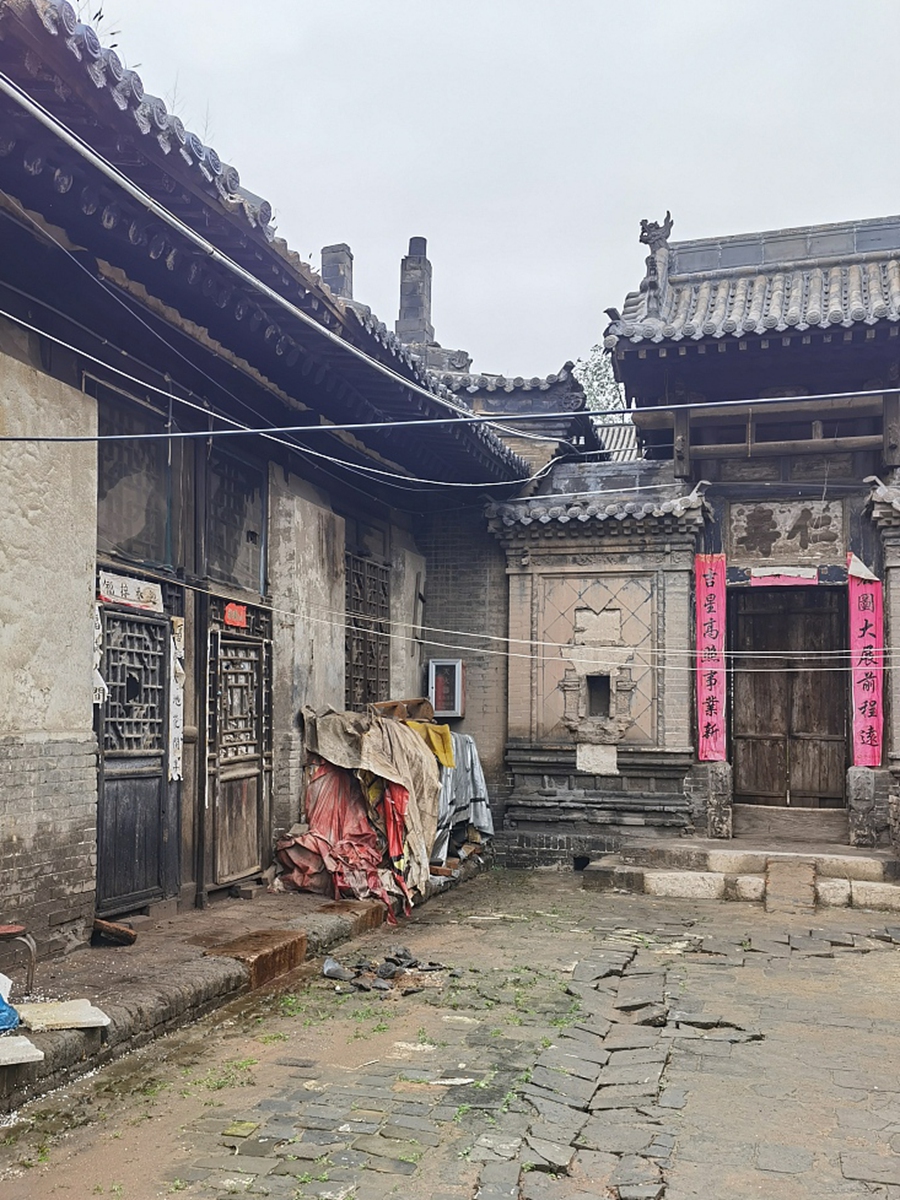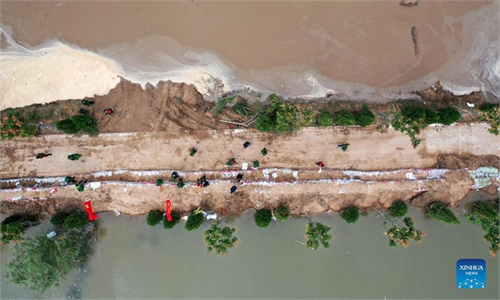Ancient buildings become silent victims of Shanxi floods
Weather forecasting and timely responses help protect fine old buildings but less known sites still need attention

The photo taken on October 7, 2021 shows a building in Pingyao ancient city damaged by floods. Photo: CFP
As North China's Shanxi Province suffered from a record-breaking rainfall and floods, thousands of ancient buildings in this historic province were also at great risk.
Fortunately, thanks to accurate weather forecasts and a timely response, most of the province's ancient buildings were protected in advance to prevent flooding and did not suffer too much damage. However, a province with abundant cultural relics like Shanxi should further promote tourism so that more people can appreciate these beautiful ancient buildings while raising funds for repairs and maintenance, experts say.
Shanxi is the province with the largest number of ancient architectural sites in the country. It is known as the "treasure house of ancient Chinese architecture" because of its complete sequence through time, numerous categories and complete forms. The province has always been dedicated to the conservation of ancient buildings. However, during the recent floods and landslides caused by days of heavy rainfall in Shanxi, there are still many ancient buildings in danger.
According to Shanxi Evening News, at least 16 national, provincial and municipal protected ancient buildings registered partial collapses, cracks or serious leaking during this rare and record-breaking continuous rainfall which also affected the safety of the surrounding houses.
In Taiyuan, capital city of Shanxi, multiple major historical and cultural sites protected at the national level were damaged to various extent, including the Jin Temple, the most prominent religious complex in Shanxi, and the Tianlongshan Grottoes notable for the Buddhist temples located inside. In some temples, roofs leaked after days of rainstorm and the retaining walls collapsed or cracked. Roads to scenic spots were also damaged by landslides because of the saturated soil.
Fortunately, thanks to accurate weather forecasts and timely responses, most of the province's fine ancient buildings were prepared in advance to prevent flooding and did not suffer too much damage, a cultural heritage conservation expert in Shanxi told the Global Times on Sunday.
"Yuncheng and Linfen, which were severely affected by the flooding, happen to be cities with relatively concentrated distribution of ancient buildings. Due to the large number and wide distribution area, some cultural relics were greatly affected," Guo Jing, Director of the Shanxi Jinjian History and Ancient Architecture Study Group, told the Global Times on Sunday.
"Fortunately, the finest of these ancient buildings, especially most of the major historical and cultural sites protected at the national and provincial level, had been protected in advance, escaping the disaster in this heavy rainstorm," Guo said.
During the National Day holidays, Guo led a delegation to Yuncheng and Linfen to visit some of the national and provincial protected historic sites that were flagged during the recent unusual continuous precipitation to strengthen the warning and protection work for cultural relics. For example, the Qinglong Temple in Jishan county, one of the areas most severely affected by the rainstorm, issued a notice of closure to carry out waterproofing and reinforcement works to protect the murals.
"We all pay close attention to the precipitation situation. Many culture relic protection sites have notified us in advance of the temporary closure because of the rain," Guo said, noting that at present the flood water is gradually receding and most of the ancient protection sites are basically back to normal.
According to the data of the third national cultural relics census, as well information from the Shanxi Provincial Cultural Relics Bureau, there were 53,875 immovable cultural relics in Shanxi by July 2020, with 28,027 ancient buildings, accounting for about 52 percent of the total, distributed in 11 cities in the province.
Shanxi's ancient buildings are most famous for their wooden structures, especially those built before the Yuan Dynasty (1271-1368), which enjoy the honor of being the "treasure house of ancient Chinese architecture". According to the data, there are 495 ancient wood buildings set up before the Yuan Dynasty remaining in Shanxi, accounting for about 85 percent of the country's 580 ancient wood structures of the same period.
As a large province with an ancient architecture, Shanxi has been committed to the repair and protection of ancient buildings. In July 2008, as part of the national cultural relics "Eleventh Five-Year Plan" project, 105 ancient edifices built before the Yuan Dynasty in four cities and 34 counties in southern Shanxi were repaired. The surrounding environment was improved and valuable engineering information was collected to explore a set of effective practices for the protection of ancient buildings. However, the status of a large number of low-grade ancient buildings is still uncertain due to financial and geographical factors.
Protecting Shanxi's ancient architecture faces many difficulties even in normal conditions. The most prominent problems are the large number of constructions, ageing sites and dispersion in rural areas, Liu Zheng, member of the China Cultural Relics Academy, told the Global Times on Sunday.
In 2017, Shanxi launched a new policy of "adoption" of low-grade cultural relics. The scheme works on the premise of maintaining the ownership of cultural relics, encourages and guides social organizations, enterprises or individuals, to participate in the protection of cultural relics and other immovable cultural relics at the municipal and county levels by funding repairs, among other activities. This is the first province in the country to introduce this policy.
But the floods created new challenges to Shanxi's preservation works on cultural relics. Liu suggested that the authorities need to find ways to collect enough funds for preservation and stepping up publicity is one of the methods.
In addition, Guo pointed out that in recent years, as a major site of cultural relics, Shanxi Province has further enhanced the importance of heritage protection of some of the treasures of ancient buildings or frescoes and sculptures in the countryside. Even if they are very remote, the roads are very well built. At the same time, civil protection forces are also actively involved in activities such as the adoption of cultural relics, allowing more cultural relics to get the deserved protection.
Liu pointed out that Shanxi has abundant tourism resources that are not promoted properly, adding that "developing tourism and attracting more visitors can provide the funds they need to preserve and repair cultural relics."
To discover damages on these ancient buildings, Liu mentioned that the local authorities need to mobilize society, including local residents, to build a safeguarding team responsible for regular patrols instead of just relying on governments, and they even can seek help from all around the country.
According to experts, the endeavor by just one province is not adequate to cover all ancient architectures in Shanxi, so the local authorities can learn from other places such as East China's Zhejiang Province.
"Zhejiang allows people who have financial capacity to claim ancient architectures and their involvement relieves the burden to authorities to maintain and repair the buildings. Maybe Shanxi can try this method," Liu noted.



